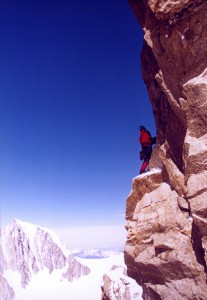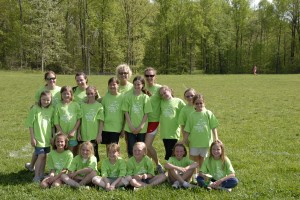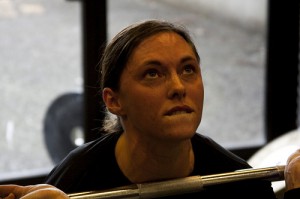 The Runner’s World triathlon training program I’m using calls for five different types of running throughout the 12 week schedule: Foundation, Strides, Transition, Tempo, and Threshold Intervals. A rather in depth article about how runners can train for a triathlon preceded the program but it didn’t go into detail about the various types of running (or swimming or biking for that matter) as there are definitions in the sidebar of the program. All of the work-outs made sense to me except for the description of Strides, which happens to be one of the first running work-outs on the schedule. The program defines it as “Run 20 seconds at 5k race pace; jog 40 seconds after each stride” and each run work-out says how many repetitions of this to do.
The Runner’s World triathlon training program I’m using calls for five different types of running throughout the 12 week schedule: Foundation, Strides, Transition, Tempo, and Threshold Intervals. A rather in depth article about how runners can train for a triathlon preceded the program but it didn’t go into detail about the various types of running (or swimming or biking for that matter) as there are definitions in the sidebar of the program. All of the work-outs made sense to me except for the description of Strides, which happens to be one of the first running work-outs on the schedule. The program defines it as “Run 20 seconds at 5k race pace; jog 40 seconds after each stride” and each run work-out says how many repetitions of this to do.
In my mind, a stride was the forward movement of the leg. I was baffled as to how I was to jog for 40 seconds in just one stride. But I knew what 5k race pace meant, so at first I would just sprint for the designated number of repetitions and not worry about the 40 seconds of jogging. The more I started to read about triathlon training, however, the more the term “strides” came up and the more I wanted to know the true meaning. Continue reading


 This long Memorial weekend was a reminder to me of a phrase I have let slip from my vocabulary–all in moderation. I went into the three day weekend with a long list of things that I wanted to do: garden, bike, go boating, hike, kayak, play beach volleyball, lay by the pool, cook-out, read, play with the dog, relax. Somehow I managed to get them all in, but only one of those activities is on
This long Memorial weekend was a reminder to me of a phrase I have let slip from my vocabulary–all in moderation. I went into the three day weekend with a long list of things that I wanted to do: garden, bike, go boating, hike, kayak, play beach volleyball, lay by the pool, cook-out, read, play with the dog, relax. Somehow I managed to get them all in, but only one of those activities is on  There is something about a long weekend, sunny, summery days, and an abundance of social gatherings that toss all training discipline and focus out the window. It’s so easy to enjoy snacking all day long when you’re on a boat or a beach and when the sun is setting but everyone is still laughing and talking, having one more drink seems to be part of the fun. By the end of the long weekend, you end up consuming more than you would on any normal day and your body is sunburned and exhausted from playing non-stop. At least that’s how I feel.
There is something about a long weekend, sunny, summery days, and an abundance of social gatherings that toss all training discipline and focus out the window. It’s so easy to enjoy snacking all day long when you’re on a boat or a beach and when the sun is setting but everyone is still laughing and talking, having one more drink seems to be part of the fun. By the end of the long weekend, you end up consuming more than you would on any normal day and your body is sunburned and exhausted from playing non-stop. At least that’s how I feel. 
 This spring I volunteered as one of three assistant coaches at Windsor Farm Elementary in Arnold, MD, for Girls on the Run. Every Tuesday and Thursday 15 third through fifth grade girls plus the coaches would meet to talk about life, confidence, making healthy choices, family, friendship, trust, self-respect, and a host of other topics designed to encourage positive emotional, social, mental, spiritual, and physical development. In short, the program teaches girls how to avoid getting stuck in “
This spring I volunteered as one of three assistant coaches at Windsor Farm Elementary in Arnold, MD, for Girls on the Run. Every Tuesday and Thursday 15 third through fifth grade girls plus the coaches would meet to talk about life, confidence, making healthy choices, family, friendship, trust, self-respect, and a host of other topics designed to encourage positive emotional, social, mental, spiritual, and physical development. In short, the program teaches girls how to avoid getting stuck in “ Every time I do a run I am forever grateful to the volunteers who line the course at the water stops, the start and finish line, the packet pick-up, the gear check–they seem to be everywhere. I’ve never really stopped long enough to think about where all the volunteers come from, or what happens behind the scenes of a race, but I know it’s a lot of work no matter the size of the race. In March I met the organizers of the ZOOMA Women’s Race Series and realized my opportunity to learn more about how a successful race comes together as well as what it means to volunteer, rather than run, a race.
Every time I do a run I am forever grateful to the volunteers who line the course at the water stops, the start and finish line, the packet pick-up, the gear check–they seem to be everywhere. I’ve never really stopped long enough to think about where all the volunteers come from, or what happens behind the scenes of a race, but I know it’s a lot of work no matter the size of the race. In March I met the organizers of the ZOOMA Women’s Race Series and realized my opportunity to learn more about how a successful race comes together as well as what it means to volunteer, rather than run, a race. There was a fun article in the May 2009 issue of
There was a fun article in the May 2009 issue of  My sister-in-law’s wedding was at a beautiful
My sister-in-law’s wedding was at a beautiful 